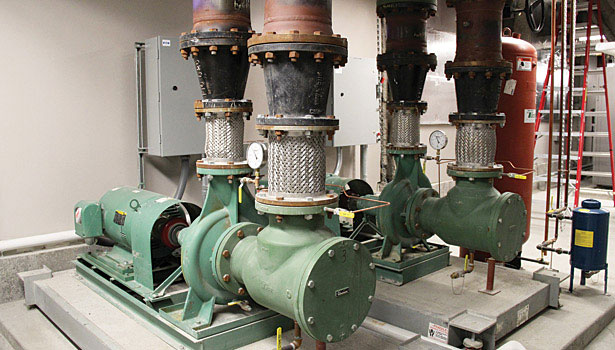Photo caption: At Waterside Place, end-suction pumps are used on the building’s central hydronic loop, in conjunction with suction diffusers and flex couplers.
Boston’s New Waterfront initiative has created an influx of business and new housing where sea meets land. Boston’s revitalized Seaport District now sports a harbor walk that meanders through shops, fine restaurants, and upscale neighborhoods.
One of the newest projects there is Waterside Place. The lower two floors of the 350,000-sq-ft luxury apartment facility consists of retail space and conference center, while the upper 17 floors are home to 236 apartments.
A tight building envelope compliments a cutting-edge heat pump system to provide occupants with a carbon footprint smaller than the roomy apartments would suggest. Designers of the high-rise are seeking LEED BD+C Gold.
Boston’s TRO Jung Brannen (TRO JB) architecture and engineering firm was sought out by the development group. TRO JB was tasked with designing the mechanical systems. Mechanical construction contractor J.C. Cannistraro took the project bid.
“By design, Waterside Place is an efficient, green, luxurious living space,” said Paul Kondrat, P.E, TRO JB’s director of HVAC engineering and associate principal. “The challenge was doing it on a budget per square-foot that was lower than what typically accompanies most LEED projects.”
Apartments and common areas are conditioned via 425 water-source heat pumps, with a total cooling load of 600 tons and a heating load of 5,600 MBH. In cooling mode, the heat pumps are served by a two-cell BAC cooling tower for heat rejection. Three, 2 million Btu modulating boilers were installed. A PEP centrifugal water separator installed on the condenser water loop removes most of the dirt that would otherwise make its way into a large heat exchanger. The separator compliments Dolphin non-chemical water treatment.
“In cooling mode, the heat pumps get entering water temp from the plate HX ranging from 87°F to 97°F,” said Jim Darragh, sales engineer at rep firm Emerson Swan, who offered product support during design, installation, and startup.
On the open side of the heat exchanger, the cooling tower takes water at 95°F EWT and sends 83°F LWT back to the cold side of the HX. In heating mode, water entering the heat pumps ranges from 75°F to 67°F.
Flow rates through either side of the exchanger are similar; roughly 1,550 gpm in heating and cooling mode. Circulation is provided by a Taco TA Series horizontal split case pump on the cooling tower side, and FI Series end-suction pumps on the central loop.
But it’s the distribution of system fluid to the heat pumps that’s most unique, and the technology used was an important facet to building a tightly-budgeted LEED Gold facility.
TRO JB was asked to design the hydronic distribution around a one-pipe Taco LoadMatch system. Commercial Construction Consulting, Inc. (C3) was the development project manager on the project.
“We have a full department of engineers on staff, each with extensive experience in their fields,” said C3 President and CEO James Kirby. “It’s based on our past experience with single-pipe hydronic systems that we chose LoadMatch for Waterside Place.”
LoadMatch is a blend of three technologies. Single-pipe distribution and primary-secondary pumping are proven technologies that — as part of a LoadMatch system — are enhanced by the use of maintenance-free, wet rotor circulators, said Taco officials.
The primary distribution system is a single-pipe loop. The secondary distribution system is a small, decoupled loop for each heat pump terminal unit. Small, low-kW LoadMatch circulators provide the specified flow to each unit, eliminating the need for control valves and balancing valves.
“Providing flow to water source heat pumps with individual circulators guarantees that each unit has the proper flow at all times and prevents heat pump lockouts often experienced with improperly balanced two-pipe systems” said Jeff Pitcairn, eastern regional manager for Taco.
Pitcairn used Taco’s HSS Hydronic System Solution software to provide design assistance early in project development.
The system is self-balancing, which reduces many start-up, commissioning, and operational problems because all zones are completely independent of each other.
In addition to the energy savings typical with hydronic systems, LoadMatch reduces head loss by eliminating many control and balancing valves, as well as some pipe. The result leads to a reduction in primary pump size by up to 50%, and total pump horsepower can be decreased by 30%, according to Greg Cunniff, P.E., application engineering manager for Taco.
The vertical Whalen heat pumps were ordered from the factory with the small LoadMatch circulators installed within the cabinets. Where a vertical configuration wasn’t feasible, several horizontal FHP heat pumps were used. On these units, the circulators were installed on-site. All the secondary circulators are between 1.8 and 4.5 gpm, depending on the size of the heat pump.
After the project went out to bid in late 2011, one came back substantially lower than the others. J.C. Cannistraro’s bid was returned quickly, and with a number that the developer could appreciate.
“We had never installed a LoadMatch job before Waterside Place,” said Project Manager Paul Battaglia. But because two Cannistraro employees had attended training sessions about the system, familiarity with LoadMatch allowed the company to bid the job aggressively.
“The system went in more quickly than a standard two-pipe system, so the labor and material savings added up,” said Battaglia. “LoadMatch delivered the efficiency needed to reach LEED, while also allowing the project to stay within the tight budget.”





